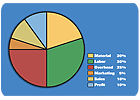Guest Column: Raising Your Price: Why, When and How
The No. 1 skill a roofing contractor needs, over and beyond performing quality work and achieving high levels of customer satisfaction, is getting the right price. The lack of the right price is the "root of most evil" in the roofing business.
.jpg)
 The No. 1 skill a roofing contractor needs, over and beyond performing quality work and achieving high levels of customer satisfaction, is getting the right price. The lack of the right price is the "root of most evil" in the roofing business.
The No. 1 skill a roofing contractor needs, over and beyond performing quality work and achieving high levels of customer satisfaction, is getting the right price. The lack of the right price is the "root of most evil" in the roofing business.
The roofing industry has done a fine job developing technical training, but it has basically dropped the ball when it comes to quality business training. Due to the lack of training, many roofing contractors do not have financial literacy. They do not how to calculate the right price and determine what returns to expect from their investment. Many roofing contractors price their work based on the so-called "going rate."
The roofing contractor's "sell price" must be based on the cost to perform the roofing work and the company's profit expectations - not on some phantom "going rate." The so-called "going rate" has been proven by many roofing contractors to be the "going broke" or "going out of business" rate.
What you will read in this article about raising your price can change your life. Over the last three decades, the following pricing insights have created highly successful roofing companies and have made many roofing contractors financially independent.
This article is not a theory, and it's not advice from someone who has never operated a profitable roofing company. This is hands-on, contractor-proven pricing "best practices" for calculating and successfully getting the right price used by roofing contractors throughout the United States and Canada. You can do it, too.

The basic rule for a profitable residential roofing or private negotiated commercial roofing company is a minimum gross profit of 50 percent. This is for companies ranging from $500,000 to $10 million, with an average unit of sale of $7,000. For example, if it costs $3,500 labor and material to install a roof, the sell price should be approximately $7,000 or greater.
A gross profit margin of 50 percent is initially a shock for many roofing contractors that might be selling that $7,000 roof for $5,000 or less due to pressure from lower-priced contractors. In future articles, we will discuss why roofing contractors need to recover all of these costs. If you are working from your home, the overhead percentage should often be higher, not lower - that is, if the business owner is to be properly paid.
Roofing contractors that are consistently profitable and get their price have a strategy that generates more leads than they can estimate 12 months a year.
Unprofitable roofing contractors that are short on leads and are afraid of losing jobs often compete against themselves and drop their price to what they think is the winning price.
Next, the profitable roofing contractors have a step-by-step process for becoming the prospect's roofing consultant, not just a roofing contractor providing shingles. The key to success in getting the right price is to appear totally different than the competition so your price is not compared to the competition.
An early step in the process is the "measure call," where the roof and the prospect are measured. During the measuring process the consultant needs to discover what the prospect wants, as well as what the prospect needs.
It is this focus on prospect's needs that differentiates the consultant from the roofer and wins the project for the consultant regardless of significantly higher prices than the roofer.
For example, the consultant rarely bids the bottom-of-the-line shingles and recommends to the prospect better-quality, longer-lasting shingles because they are the best value for the prospect.
Some contractors typically bid the lowest-cost shingle because they believe the customer buys price and low price wins the job. The difference between shingles and professionalism is easily understood by the prospect, often triggering rejection of the roofing contractor's lower price since it is not responsive to the prospect's needs.
Another common mistake involves trying to sell by explaining how long the company has been in business, noting that it's a family business, touting a long-term warranty, etc. Since most roofing contractors tell similar stories, from the prospect's perspective there is often little difference between contractors except for price.
In stark contrast, the consultant provides the prospect with questions that help the prospect define (1) the scope of work, (2) specifications and (3) contractor selection criteria - instead of focusing solely on price. As a result, consultants always get more than their fair share of work because the educated prospect does not buy on price. Prospects buy based on trust and confidence and other more important factors.
Getting the right price is a critical success factor for any roofing contractor. Revenue from our roofing projects is what pays for quality labor, employee/sub training, and the salary and benefits that attract and retain top personnel. It also funds safety programs, buys new equipment and fuels the company's growth.
Unfortunately, getting the right price is a real challenge for a high percentage of companies in the roofing industry because of the lack of quality business training. As roofing contractors, we don't know what we don't know, so when it comes to pricing, in many cases the blind are leading the blind.
.jpg)

The roofing industry has done a fine job developing technical training, but it has basically dropped the ball when it comes to quality business training. Due to the lack of training, many roofing contractors do not have financial literacy. They do not how to calculate the right price and determine what returns to expect from their investment. Many roofing contractors price their work based on the so-called "going rate."
Why You Should Raise Your Price
The "going rate" throughout most of the United States is typically 30 percent lower than the actual rate a roofing contractor needs to build a viable business. Without the right price, the roofing contactor cannot provide the proper training, the proper equipment and safety instructions, and the proper compensation and benefits packages that attract and retain quality personnel.The roofing contractor's "sell price" must be based on the cost to perform the roofing work and the company's profit expectations - not on some phantom "going rate." The so-called "going rate" has been proven by many roofing contractors to be the "going broke" or "going out of business" rate.
What you will read in this article about raising your price can change your life. Over the last three decades, the following pricing insights have created highly successful roofing companies and have made many roofing contractors financially independent.
This article is not a theory, and it's not advice from someone who has never operated a profitable roofing company. This is hands-on, contractor-proven pricing "best practices" for calculating and successfully getting the right price used by roofing contractors throughout the United States and Canada. You can do it, too.

Click image for larger view.
When to Raise Your Price
Now is the time to make sure your price is right. There have been and there will continue to be rapidly increasing costs for material and labor as the result of Katrina and other factors.The basic rule for a profitable residential roofing or private negotiated commercial roofing company is a minimum gross profit of 50 percent. This is for companies ranging from $500,000 to $10 million, with an average unit of sale of $7,000. For example, if it costs $3,500 labor and material to install a roof, the sell price should be approximately $7,000 or greater.
A gross profit margin of 50 percent is initially a shock for many roofing contractors that might be selling that $7,000 roof for $5,000 or less due to pressure from lower-priced contractors. In future articles, we will discuss why roofing contractors need to recover all of these costs. If you are working from your home, the overhead percentage should often be higher, not lower - that is, if the business owner is to be properly paid.
How to Get the Right Price
The key to getting the right price is the company's lead flow. Sales leads are the lifeblood of a roofing company, but many roofing contractors give marketing little effort. Many live off referrals, which can be bad, not good, if the referral expects a ridiculously low price.Roofing contractors that are consistently profitable and get their price have a strategy that generates more leads than they can estimate 12 months a year.
Unprofitable roofing contractors that are short on leads and are afraid of losing jobs often compete against themselves and drop their price to what they think is the winning price.
Next, the profitable roofing contractors have a step-by-step process for becoming the prospect's roofing consultant, not just a roofing contractor providing shingles. The key to success in getting the right price is to appear totally different than the competition so your price is not compared to the competition.
An early step in the process is the "measure call," where the roof and the prospect are measured. During the measuring process the consultant needs to discover what the prospect wants, as well as what the prospect needs.
It is this focus on prospect's needs that differentiates the consultant from the roofer and wins the project for the consultant regardless of significantly higher prices than the roofer.
For example, the consultant rarely bids the bottom-of-the-line shingles and recommends to the prospect better-quality, longer-lasting shingles because they are the best value for the prospect.
Some contractors typically bid the lowest-cost shingle because they believe the customer buys price and low price wins the job. The difference between shingles and professionalism is easily understood by the prospect, often triggering rejection of the roofing contractor's lower price since it is not responsive to the prospect's needs.
Another common mistake involves trying to sell by explaining how long the company has been in business, noting that it's a family business, touting a long-term warranty, etc. Since most roofing contractors tell similar stories, from the prospect's perspective there is often little difference between contractors except for price.
In stark contrast, the consultant provides the prospect with questions that help the prospect define (1) the scope of work, (2) specifications and (3) contractor selection criteria - instead of focusing solely on price. As a result, consultants always get more than their fair share of work because the educated prospect does not buy on price. Prospects buy based on trust and confidence and other more important factors.
Getting the right price is a critical success factor for any roofing contractor. Revenue from our roofing projects is what pays for quality labor, employee/sub training, and the salary and benefits that attract and retain top personnel. It also funds safety programs, buys new equipment and fuels the company's growth.
Unfortunately, getting the right price is a real challenge for a high percentage of companies in the roofing industry because of the lack of quality business training. As roofing contractors, we don't know what we don't know, so when it comes to pricing, in many cases the blind are leading the blind.
Looking for a reprint of this article?
From high-res PDFs to custom plaques, order your copy today!



